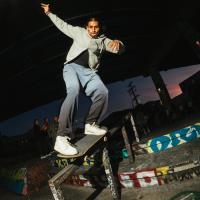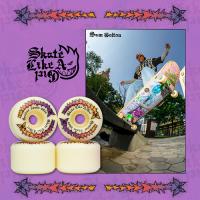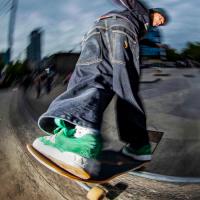How to Start a Skate Nonprofit
2/12/2021
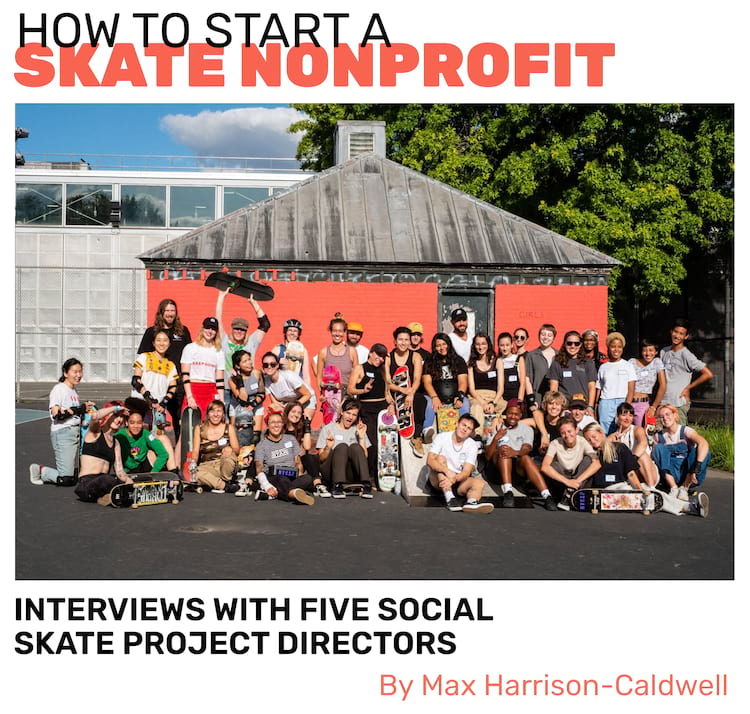 Want to give back to skateboarding without starting a struggling shop or a directionless brand? Now you can! Over the last decade, there’s been an explosion of social skate projects across the globe—from tiny youth programs to world-renowned nonprofits. These not-for-profit organizations often focus on making skating accessible for people facing financial or social barriers and work to benefit their communities through skateboarding. But how does one start such a project, where does the funding come from and what’s the first step? We sat down with five social skate project directors to find out.
Want to give back to skateboarding without starting a struggling shop or a directionless brand? Now you can! Over the last decade, there’s been an explosion of social skate projects across the globe—from tiny youth programs to world-renowned nonprofits. These not-for-profit organizations often focus on making skating accessible for people facing financial or social barriers and work to benefit their communities through skateboarding. But how does one start such a project, where does the funding come from and what’s the first step? We sat down with five social skate project directors to find out.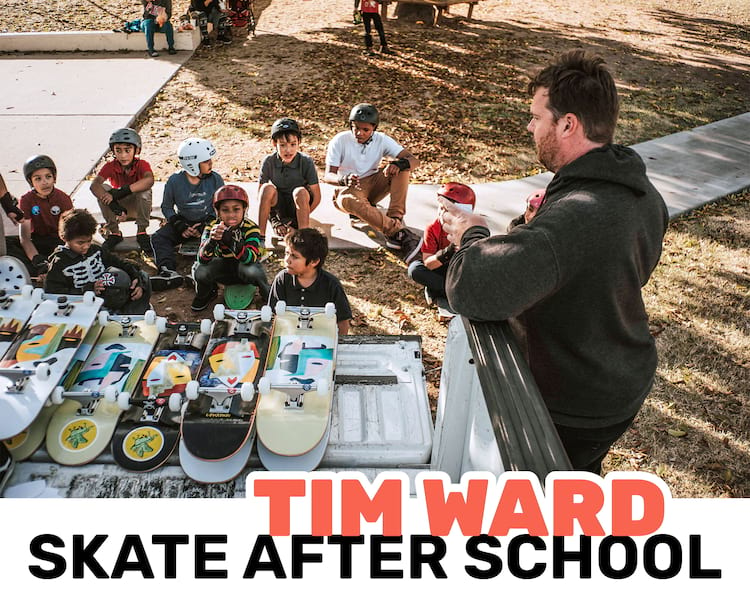
Tell me about your project.
Skate After School is a nonprofit after-school skateboarding program that I run with Ryan Lay and Bobby Green, along with a pretty big group of volunteers and board members. We provide skateboards, gear and some loose instruction and facilitate really fun and safe after-school skate clubs to kids in what are considered some of the underserved communities in Phoenix.
How did you get started?
It was 2010 when we first started trying to collect gear, but that was before we had a name for it. Early on, we were just collecting boards for a community center and the idea was just to give them the boards. We got the boards and then once we brought them to the community center we were like, “Someone needs to show the kids how to use them,” so I started going on Fridays before I went to work. I believe that we started doing programming in 2013. That was when we first went to a school and not just the community center. We were bringing ten-to-twelve boards with us.
How did you get your program into public schools?
One of our first programs in a public school, we kind of got ushered in by the PE teacher. He had a lot of freedom and autonomy to do things and I think it was kind of an ask-for-forgiveness-not-permission type of thing. It started with a small group of kids who would stay after school and skate in the gym and it was pretty loose. We didn’t even have helmets or anything at that time. By the next year it was a full program they were going to offer—Skate After School was something you could sign up for. What that did for us was to show us that we were onto something that could work. There's a group of kids that show up every week and love it. Rather than being like, We’re gonna start this program and it’s gonna be great, we already had something that people could look at and see that we had kids showing up after school of their own choice. And then after we had that school, we had momentum to approach other schools and say, “Hey, we have this program—we have 30 kids show up every week and it’s totally voluntary.” Schools take notice of that stuff. When you have an activity that 30 or 40 kids are showing up to completely voluntarily, they take notice, or at least the cool ones do. They’re looking for stuff that kids will like. That’s a big challenge for schools—finding activities kids connect to, so momentum is a big factor.
Hear from the kids at SAS what the program's all about
What are some apprehensions people might have about starting a skate program?
I think the commitment is a hard thing for people to do. Presumably, no one’s gonna be paid, at least not at first—or possibly ever. Maybe they’re a student who wants to start something but they’re gonna be graduating and getting a job. I would say that one apprehension is people not being sure they can commit to something for a long time. Another thing is just red tape. Sometimes people see us working at public schools and they want to know how we even get a principal or a school district to be on board with that. There’s not a lot of context for what we’re doing—it’s not like you just fill out some forms. It’s not a known process, so I think a lot of people can be intimidated by jumping into the unknown.
What was your biggest challenge in starting your program?
Personally, the biggest challenge was seeing it as something that could actually be something. I knew nothing about nonprofits and how they are legit things that can be a person's job/career. So in the beginning, collecting skateboard parts, building boards, taking them to a community center and skating with kids was not much of a challenge, but seeing potential in the project and seeing it as a longer-term and substantial project was and still is a challenge at times.
What's your biggest challenge in maintaining it?
Of course funding is the biggest challenge in maintaining programs like ours. We fundraise and write grants, but we ultimately are at the mercy of whatever is available to us through those channels. It's amazing to be supported in that way but it can also be stressful and can make long-term planning difficult. Maintaining the fun aspects of the program is easy, though. We love doing this and as long as kids love to ride skateboards we'll have some type of program happening, whether it's our job or not.

Skate After School is a nonprofit after-school skateboarding program that I run with Ryan Lay and Bobby Green, along with a pretty big group of volunteers and board members. We provide skateboards, gear and some loose instruction and facilitate really fun and safe after-school skate clubs to kids in what are considered some of the underserved communities in Phoenix.
How did you get started?
It was 2010 when we first started trying to collect gear, but that was before we had a name for it. Early on, we were just collecting boards for a community center and the idea was just to give them the boards. We got the boards and then once we brought them to the community center we were like, “Someone needs to show the kids how to use them,” so I started going on Fridays before I went to work. I believe that we started doing programming in 2013. That was when we first went to a school and not just the community center. We were bringing ten-to-twelve boards with us.
How did you get your program into public schools?
One of our first programs in a public school, we kind of got ushered in by the PE teacher. He had a lot of freedom and autonomy to do things and I think it was kind of an ask-for-forgiveness-not-permission type of thing. It started with a small group of kids who would stay after school and skate in the gym and it was pretty loose. We didn’t even have helmets or anything at that time. By the next year it was a full program they were going to offer—Skate After School was something you could sign up for. What that did for us was to show us that we were onto something that could work. There's a group of kids that show up every week and love it. Rather than being like, We’re gonna start this program and it’s gonna be great, we already had something that people could look at and see that we had kids showing up after school of their own choice. And then after we had that school, we had momentum to approach other schools and say, “Hey, we have this program—we have 30 kids show up every week and it’s totally voluntary.” Schools take notice of that stuff. When you have an activity that 30 or 40 kids are showing up to completely voluntarily, they take notice, or at least the cool ones do. They’re looking for stuff that kids will like. That’s a big challenge for schools—finding activities kids connect to, so momentum is a big factor.
Hear from the kids at SAS what the program's all about
What are some apprehensions people might have about starting a skate program?
I think the commitment is a hard thing for people to do. Presumably, no one’s gonna be paid, at least not at first—or possibly ever. Maybe they’re a student who wants to start something but they’re gonna be graduating and getting a job. I would say that one apprehension is people not being sure they can commit to something for a long time. Another thing is just red tape. Sometimes people see us working at public schools and they want to know how we even get a principal or a school district to be on board with that. There’s not a lot of context for what we’re doing—it’s not like you just fill out some forms. It’s not a known process, so I think a lot of people can be intimidated by jumping into the unknown.
What was your biggest challenge in starting your program?
Personally, the biggest challenge was seeing it as something that could actually be something. I knew nothing about nonprofits and how they are legit things that can be a person's job/career. So in the beginning, collecting skateboard parts, building boards, taking them to a community center and skating with kids was not much of a challenge, but seeing potential in the project and seeing it as a longer-term and substantial project was and still is a challenge at times.
What's your biggest challenge in maintaining it?
Of course funding is the biggest challenge in maintaining programs like ours. We fundraise and write grants, but we ultimately are at the mercy of whatever is available to us through those channels. It's amazing to be supported in that way but it can also be stressful and can make long-term planning difficult. Maintaining the fun aspects of the program is easy, though. We love doing this and as long as kids love to ride skateboards we'll have some type of program happening, whether it's our job or not.

What’s your advice to someone who wants to start a skate program?
It can be something really simple—get a few boards together, find a Boys & Girls Club or a school that’s interested and find that one PE teacher who doesn’t think skateboarding is bad, but ultimately try to do something small and manageable. Maybe try to create a mini version of what you're hoping to do and then build from there. But also keep in mind that anything you do will be cool. If you build one board and get it to a kid, that rules. If you set up one session that brings people together to skate, that rules, too. Anything you can do that isn't already happening is rad and you should be hyped.
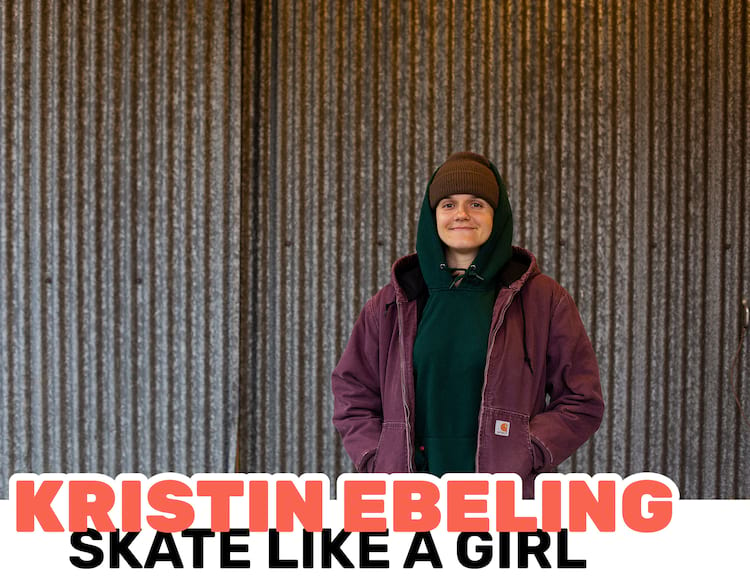
Tell me about your project.
Skate Like a Girl creates a more inclusive community by promoting confidence, leadership and social justice through skateboarding. What that really means is we try to serve skaters who aren't already showing up, or are underrepresented in skateboarding. We have three key chapters in Seattle, Portland and the Bay Area and serve around 12,000 people each year. Our key programs include Women & Trans sessions, skate camps and after-school programs. Due to COVID, we've been doing gear distribution clinics with high-needs community partners, uploading tutorial content on our YouTube page, running virtual at-home camps and hosting a youth advisory board program for teens and young adults.
SLAG adapted to the pandemic and kept the stoke high. See how the Seattle chapter stays on course
How did you get started?
The founders, Holly Sheehan and Fleur Larsen, started Skate Like a Girl in Olympia, WA, a few years before I got involved in 2006. They wanted to start hosting skateboarding clinics to get more women and queer people into board sports. Snowboarding and surfing are pretty expensive, so they went with skateboarding because they thought it was the coolest in terms of being more equitable and accessible. So they started it and for a few years they ran programs in Olympia, then they all moved up to Seattle. When I joined, I wanted to start doing two things: one was to have more regular women’s meet-ups. There was an indoor park I went to called Skate Barn and I rode for the team. It was 30 minutes south of Seattle and they had girl skate hours on Wednesdays. I started promoting that and trying to get more girls to come out and skate. That was crucial—meeting the existing girls in the scene and building a foundation. The second thing was we started doing youth clinics. We partnered with a different indoor park in Seattle. At first it was just for little girls but then we noticed that little boys were showing up, too. Dads would show up with two kids and be helping in the group and random skaters would come teach. It was very informal and pretty mellow. We were also collecting donations which gave us money to do pizza parties for the volunteers. It was very community oriented in the beginning.
What was your biggest challenge when you started?
I volunteered for eight years before getting paid for any of my work, so I would say at first it was hard to manage my time and keep my commitments, knowing that I had to prioritize other things like work and school. It's easy to burn out, so I had to learn to take things slow and steady. When I became a paid coordinator, there really was no shortage of new challenges. Generally, I think the hardest thing in nonprofit work is knowing what to prioritize. In a given day I have meetings, grant writing, planning, events, budgeting and beyond. You definitely have to take it one day at a time!

It can be something really simple—get a few boards together, find a Boys & Girls Club or a school that’s interested and find that one PE teacher who doesn’t think skateboarding is bad, but ultimately try to do something small and manageable. Maybe try to create a mini version of what you're hoping to do and then build from there. But also keep in mind that anything you do will be cool. If you build one board and get it to a kid, that rules. If you set up one session that brings people together to skate, that rules, too. Anything you can do that isn't already happening is rad and you should be hyped.

Tell me about your project.
Skate Like a Girl creates a more inclusive community by promoting confidence, leadership and social justice through skateboarding. What that really means is we try to serve skaters who aren't already showing up, or are underrepresented in skateboarding. We have three key chapters in Seattle, Portland and the Bay Area and serve around 12,000 people each year. Our key programs include Women & Trans sessions, skate camps and after-school programs. Due to COVID, we've been doing gear distribution clinics with high-needs community partners, uploading tutorial content on our YouTube page, running virtual at-home camps and hosting a youth advisory board program for teens and young adults.
SLAG adapted to the pandemic and kept the stoke high. See how the Seattle chapter stays on course
How did you get started?
The founders, Holly Sheehan and Fleur Larsen, started Skate Like a Girl in Olympia, WA, a few years before I got involved in 2006. They wanted to start hosting skateboarding clinics to get more women and queer people into board sports. Snowboarding and surfing are pretty expensive, so they went with skateboarding because they thought it was the coolest in terms of being more equitable and accessible. So they started it and for a few years they ran programs in Olympia, then they all moved up to Seattle. When I joined, I wanted to start doing two things: one was to have more regular women’s meet-ups. There was an indoor park I went to called Skate Barn and I rode for the team. It was 30 minutes south of Seattle and they had girl skate hours on Wednesdays. I started promoting that and trying to get more girls to come out and skate. That was crucial—meeting the existing girls in the scene and building a foundation. The second thing was we started doing youth clinics. We partnered with a different indoor park in Seattle. At first it was just for little girls but then we noticed that little boys were showing up, too. Dads would show up with two kids and be helping in the group and random skaters would come teach. It was very informal and pretty mellow. We were also collecting donations which gave us money to do pizza parties for the volunteers. It was very community oriented in the beginning.
What was your biggest challenge when you started?
I volunteered for eight years before getting paid for any of my work, so I would say at first it was hard to manage my time and keep my commitments, knowing that I had to prioritize other things like work and school. It's easy to burn out, so I had to learn to take things slow and steady. When I became a paid coordinator, there really was no shortage of new challenges. Generally, I think the hardest thing in nonprofit work is knowing what to prioritize. In a given day I have meetings, grant writing, planning, events, budgeting and beyond. You definitely have to take it one day at a time!

How has your programming changed over the years?
Our program was called Girls in Space and then we ended up making it Kids in Space because so many people were bringing their siblings. There are also kids who don’t know what gender they are, so we were like, Fuck it, we’re just gonna make it for kids. Okay, cool—we have an all-gender program. Now all these teenagers, older siblings and other skaters need community-service hours and want to volunteer, so we started a teen volunteer program called Youth Employment Skateboarding. It’s been evolving constantly. Don’t think that the first thing you do will be the thing you always do. You might hit the nail on the head right out the gate, but at least for us, we’ve always been evolving to match what the community needed. Community needs are gonna evolve so you can’t be static or you’ll become irrelevant. Now we’ve narrowed our scope a little. Our thought when opening up Girls in Space was that if little boys were learning from women and queer people, what’s not radical about that? A little boy saying, “Yeah, a girl taught me how to drop in.” But now that there are so many skate programs, we’re getting DMs and emails from little girls saying “I want a space to meet other little girls who skate,” and that wasn’t a demand before. Same thing with our Women & Trans Night. It used to be called Ladies Night. We changed the name to Women & Trans to be more inclusive and more intentional about serving the trans community and welcoming that community in as instructors, participants and as skaters. We used to have cis men helping at that program because we thought, Whatever, men can’t skate here but they can help instruct. And we actually changed that as well because our community was like, Hey, we would love if everybody who taught and everybody in the space was not a cis dude. We got too broad and had to narrow it back down, but it was all based on feedback from our community and the natural ebb and flow.
What's your biggest challenge in maintaining your project?
I continually try to focus on what is "evergreen" or sustainable going into the future. Like, what can we do realistically, powerfully and do for years to come? I'm really a jump-in-and-just-do-it person, so I've had to really work on making sure things are documented, intentional and always setting a good precedent. Luckily, I have an awesome team to support me in maintaining Skate Like a Girl.
What’s one thing you wish you had known when you were starting out?
Quality over quantity. For a long time I was really focused on changing the mind of your average citizen about who skateboarders are and why what we did was important, and I realized we don’t have anything to prove except to the people that we serve. There are gonna be people who think skaters are just jerks or think skaters are all 25-year-old white dudes. I know that’s not true, our participants know that’s not true and what we’re doing is amazingly impactful and I don’t really need to prove that to anybody. For a long time I was thinking, All these people think skateboarding is a joke, it’s not powerful, it’s not radical, it’s not diverse enough, so I have to do all these programs, all these things. I almost burnt myself out to the point where I didn’t want to do it anymore. I wish back in the day someone was like, “You’ve got nothing to prove. Quality not quantity. Do less, but do it well and know that you’re making an impact. You don’t have to change the minds of the whole world.” That was too big of a goal for me and I didn’t even realize it yet. My goal should have been more centered on my community and making space for my community. It’s definitely more about a larger impact versus a broader impact.
What’s your advice to someone who wants to start a skate program?
If not you, then who? If not now, then when?

Tell me about your project.
Jason: Curb is an Austin-based after-school skateboarding club for new and experienced skaters. We give students a safe and fun place to go after school where they can learn about confidence, creativity and community through the process of skateboarding. On one level, Curb is a place for young people to go to after school. They get to show up as themselves—no uniforms, no equipment, no fees. It’s just a place to ride a skateboard no matter if you have never done it or if it’s something you already love to do. On a deeper level, Curb uses the values baked into riding a skateboard—play as an expression of imagination or as a form of practice, receiving group encouragement—not only for succeeding but also attempting, not being a gendered activity/space—and hopes that students incorporate what happens at Curb into how they move through the world.
How did you get started?
Jason: We met to float the idea of Curb at the end of summer 2018, and probably about a month later we were running the program in our first school. Two things helped get it off the ground—the first was that Ryan Lay from Skate After School was generous enough to share his time and really made us feel like we could do it. The second was that one of our friends who skated was also a high-school teacher. That helped garner some trust since we didn’t have any prior experience. So getting started was the easy part because we had the perfect combination of support and do-it-yourself naïveté. I think we just pulled together any skateboards laying around, spent a little bit of money to build a couple obstacles and got rolling. Rather than it being like, Curb is coming to the high school to run the after-school program, our teacher friend formed a skate club that meets once a week and we’re essentially hosting that club. But officially it’s a club associated with the high school. So for that process, the teacher just asked the principal if it was okay and the principal said, “Sure.” The students have to sign a waiver from us as well as one from the high school and get their guardian’s signature. For the elementary school, we also met another individual who was out skating one day who had heard about Curb and he was like, “I teach at an elementary school. It would be cool if you guys came.” For that one, he connected us with the after-school program coordinator, and that was a much more legitimate process in that it was through the school district, so we had to fill out paperwork and do some training and provide curriculum and stuff like that.
What kind of curriculum do you provide?
Tony: A lot of schools these days are working with SEL—Social Emotional Learning. There are a lot of different programs for students to learn relationship skills and social awareness, so they kind of want the programs to be based around that. With skateboarding, we make a lesson plan based on those each week. For social awareness, we’ll make a lesson plan that has students be aware of their surroundings while they’re skating.
Jason: SEL is basically self-managing, self-awareness, emotional awareness, relationship skills and responsible decision making. We were getting started and imagining what the curriculum would be, and we kinda knew that we were gonna have to have a vocabulary that would allow us to translate what we think is beneficial about skateboarding into a more academic environment. We did a bunch of research around the topic and we actually were pretty familiar with the concepts and thought they did fit in with skateboarding.

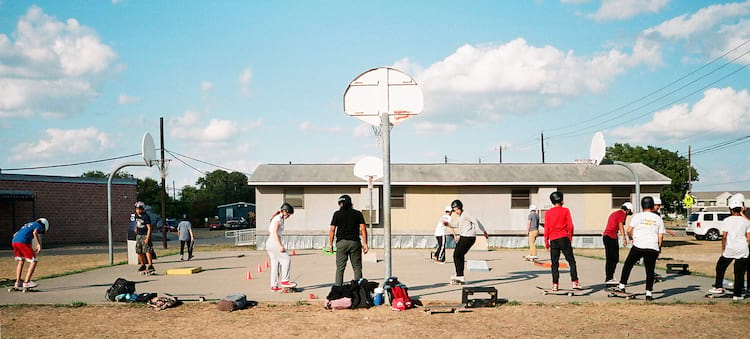 Ramps, rails, cones and boxes, Curb's got all the staples to get a heavy slab session going
Ramps, rails, cones and boxes, Curb's got all the staples to get a heavy slab session going
What’s your biggest challenge in maintaining it?
Tony: It seems like Curb is growing faster than we thought it would, and as a two-person team, time is becoming more of a challenge with all the duties that come with starting a nonprofit community project. Running Curb is a time commitment we are happy to do, but it's hard to think about how we can start a volunteer program when we're still learning about running an effective after-school skate club that follows our mission and adds to our skate community in a positive way.
Jason: We always remained a community project because we wanted the freedom to dabble and figure out what Curb wants to be and what role it should play in the community. Curb is just Tony and me, and since we’re not official, liability is kind of tricky with volunteers. Before COVID, we were at an elementary and a high school, which was about eight hours of volunteering a week when it was all said and done. So, that’s not a very scalable model.
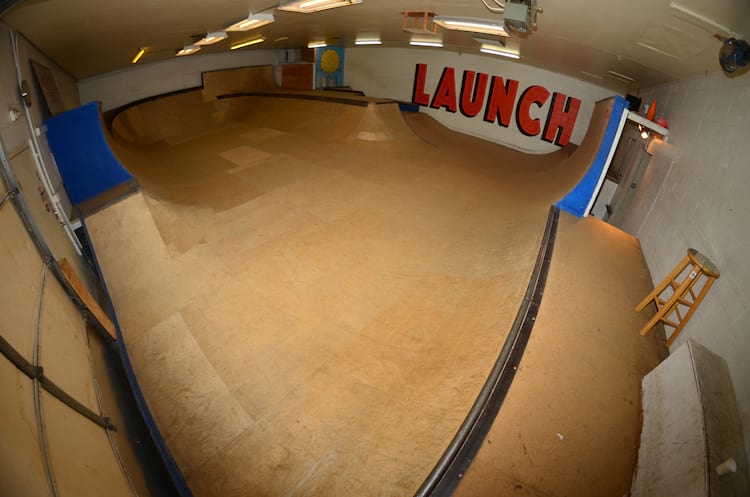 Launch's indoor park is a combined feat of woodworking and skateboarding, both of which the kids learn here
Launch's indoor park is a combined feat of woodworking and skateboarding, both of which the kids learn here
How do you fund your nonprofit?
Grant funding, corporate support and donations. Our mission is pretty open ended—we empower individuals to better themselves and their communities through skateboarding—so the grants we can seek are pretty diverse. Most grants focus on a specific category. For example, we might seek grant funding for youth anti-obesity programs. We’ve been generously funded for our art-based programs, we’ve received funding for youth-specific engagement and we receive support from health-conscious funders who support people getting outdoors and doing activities. So there’s a wide spectrum of support, and most of the foundations we work with are specific to our area. We also receive tons of small donations from community members. I did leverage some of my connections in the skateboard community to do our first fundraisers, so having a background in the skateboard industry was definitely helpful in the beginning. We still receive some support from the industry, but most of the companies that support us are either sponsoring a particular program or they’re donating product to assist with our events. For any upstart nonprofit, you gotta think about both what you need and what the benefit for the company is, too. They benefit by connecting to the customers and our organization connects with a lot of young skateboarders. Those connections with the skateboard companies took a little while. At first it was hard for them to understand what we were doing here in Northern CO. Keep in mind this was ten years ago. This was a pretty new idea at the time.
What are the advantages of running a nonprofit rather than a skateshop?
In a lot of ways it still kind of feels like I’m self-employed, but in retail it was more challenging to collaborate with other businesses. In the nonprofit world, everyone wants to help each other. We’ve had a lot more positive collaborative experiences because we can work with other nonprofits that also work with a similar demographic and have similar goals. Not to say skateshops don’t collaborate with other businesses, but I found it easier in the nonprofit world. There’s a lot of people who are just trying to help others in the nonprofit world. Launch also has a board of directors. It’s a good collective of different people who provide great insight into the direction of the organization. I do like that process. They keep me in check and help move Launch forward. With a skateshop, it’s easier to get tunnel vision. Having a board kind of keeps me accountable and keeps us focused on our universal goal.
Any downsides?
It took me a while to get into the nonprofit mindset. Obviously your revenue streams are gonna be different. Skateshops plan with pre-ordering product and those types of things, with specific seasons where you’re gonna sell certain products. With a nonprofit, we have overhead, rent to pay, a skatepark to fund, insurance to cover, so I think we have to project a little further out. In my experience, there’s a lot more planning.

Our program was called Girls in Space and then we ended up making it Kids in Space because so many people were bringing their siblings. There are also kids who don’t know what gender they are, so we were like, Fuck it, we’re just gonna make it for kids. Okay, cool—we have an all-gender program. Now all these teenagers, older siblings and other skaters need community-service hours and want to volunteer, so we started a teen volunteer program called Youth Employment Skateboarding. It’s been evolving constantly. Don’t think that the first thing you do will be the thing you always do. You might hit the nail on the head right out the gate, but at least for us, we’ve always been evolving to match what the community needed. Community needs are gonna evolve so you can’t be static or you’ll become irrelevant. Now we’ve narrowed our scope a little. Our thought when opening up Girls in Space was that if little boys were learning from women and queer people, what’s not radical about that? A little boy saying, “Yeah, a girl taught me how to drop in.” But now that there are so many skate programs, we’re getting DMs and emails from little girls saying “I want a space to meet other little girls who skate,” and that wasn’t a demand before. Same thing with our Women & Trans Night. It used to be called Ladies Night. We changed the name to Women & Trans to be more inclusive and more intentional about serving the trans community and welcoming that community in as instructors, participants and as skaters. We used to have cis men helping at that program because we thought, Whatever, men can’t skate here but they can help instruct. And we actually changed that as well because our community was like, Hey, we would love if everybody who taught and everybody in the space was not a cis dude. We got too broad and had to narrow it back down, but it was all based on feedback from our community and the natural ebb and flow.
What's your biggest challenge in maintaining your project?
I continually try to focus on what is "evergreen" or sustainable going into the future. Like, what can we do realistically, powerfully and do for years to come? I'm really a jump-in-and-just-do-it person, so I've had to really work on making sure things are documented, intentional and always setting a good precedent. Luckily, I have an awesome team to support me in maintaining Skate Like a Girl.
What’s one thing you wish you had known when you were starting out?
Quality over quantity. For a long time I was really focused on changing the mind of your average citizen about who skateboarders are and why what we did was important, and I realized we don’t have anything to prove except to the people that we serve. There are gonna be people who think skaters are just jerks or think skaters are all 25-year-old white dudes. I know that’s not true, our participants know that’s not true and what we’re doing is amazingly impactful and I don’t really need to prove that to anybody. For a long time I was thinking, All these people think skateboarding is a joke, it’s not powerful, it’s not radical, it’s not diverse enough, so I have to do all these programs, all these things. I almost burnt myself out to the point where I didn’t want to do it anymore. I wish back in the day someone was like, “You’ve got nothing to prove. Quality not quantity. Do less, but do it well and know that you’re making an impact. You don’t have to change the minds of the whole world.” That was too big of a goal for me and I didn’t even realize it yet. My goal should have been more centered on my community and making space for my community. It’s definitely more about a larger impact versus a broader impact.
What’s your advice to someone who wants to start a skate program?
If not you, then who? If not now, then when?

Tell me about your project.
Jason: Curb is an Austin-based after-school skateboarding club for new and experienced skaters. We give students a safe and fun place to go after school where they can learn about confidence, creativity and community through the process of skateboarding. On one level, Curb is a place for young people to go to after school. They get to show up as themselves—no uniforms, no equipment, no fees. It’s just a place to ride a skateboard no matter if you have never done it or if it’s something you already love to do. On a deeper level, Curb uses the values baked into riding a skateboard—play as an expression of imagination or as a form of practice, receiving group encouragement—not only for succeeding but also attempting, not being a gendered activity/space—and hopes that students incorporate what happens at Curb into how they move through the world.
How did you get started?
Jason: We met to float the idea of Curb at the end of summer 2018, and probably about a month later we were running the program in our first school. Two things helped get it off the ground—the first was that Ryan Lay from Skate After School was generous enough to share his time and really made us feel like we could do it. The second was that one of our friends who skated was also a high-school teacher. That helped garner some trust since we didn’t have any prior experience. So getting started was the easy part because we had the perfect combination of support and do-it-yourself naïveté. I think we just pulled together any skateboards laying around, spent a little bit of money to build a couple obstacles and got rolling. Rather than it being like, Curb is coming to the high school to run the after-school program, our teacher friend formed a skate club that meets once a week and we’re essentially hosting that club. But officially it’s a club associated with the high school. So for that process, the teacher just asked the principal if it was okay and the principal said, “Sure.” The students have to sign a waiver from us as well as one from the high school and get their guardian’s signature. For the elementary school, we also met another individual who was out skating one day who had heard about Curb and he was like, “I teach at an elementary school. It would be cool if you guys came.” For that one, he connected us with the after-school program coordinator, and that was a much more legitimate process in that it was through the school district, so we had to fill out paperwork and do some training and provide curriculum and stuff like that.
What kind of curriculum do you provide?
Tony: A lot of schools these days are working with SEL—Social Emotional Learning. There are a lot of different programs for students to learn relationship skills and social awareness, so they kind of want the programs to be based around that. With skateboarding, we make a lesson plan based on those each week. For social awareness, we’ll make a lesson plan that has students be aware of their surroundings while they’re skating.
Jason: SEL is basically self-managing, self-awareness, emotional awareness, relationship skills and responsible decision making. We were getting started and imagining what the curriculum would be, and we kinda knew that we were gonna have to have a vocabulary that would allow us to translate what we think is beneficial about skateboarding into a more academic environment. We did a bunch of research around the topic and we actually were pretty familiar with the concepts and thought they did fit in with skateboarding.

What was your biggest challenge in starting your program?
Jason: Well, because it’s a pretty DIY operation, one thing I would recommend is that anyone starting something like this be on the same page regarding the liability of all of it. Nothing is protecting us except the waiver, and that made some people feel very uncomfortable—and rightfully so. So that was a challenge. We started with three people but because we weren’t really sure how to legitimize it, we lacked the mechanisms to protect ourselves from any liability and one individual wasn’t so down with that. Having three people versus two people makes a huge difference, especially when working with younger kids. I think what we’ve been learning, since this is our first semester working with the elementary school kids, is that it becomes a lot more than just skateboarding with the kids. There’s a certain kind of structure that you need. Since we’re folded into the after-school program, we sit with the kids and they eat their after-school meal, then we go skate and then we help them with their homework. So it’s a pretty significant time commitment.
Tony: We planned exactly what we wanted to do with Curb from the very beginning, I think it helped us get to our first session quicker, but as the session went on we quickly learned that we needed to listen to our students and make sure Curb is what they wanted, too. As we added more students and different schools, the challenge we were facing was making sure that each different group was getting the same positive experience while still incorporating our core values. Adapting to each group's needs wasn't something we were expecting.
Jason: Well, because it’s a pretty DIY operation, one thing I would recommend is that anyone starting something like this be on the same page regarding the liability of all of it. Nothing is protecting us except the waiver, and that made some people feel very uncomfortable—and rightfully so. So that was a challenge. We started with three people but because we weren’t really sure how to legitimize it, we lacked the mechanisms to protect ourselves from any liability and one individual wasn’t so down with that. Having three people versus two people makes a huge difference, especially when working with younger kids. I think what we’ve been learning, since this is our first semester working with the elementary school kids, is that it becomes a lot more than just skateboarding with the kids. There’s a certain kind of structure that you need. Since we’re folded into the after-school program, we sit with the kids and they eat their after-school meal, then we go skate and then we help them with their homework. So it’s a pretty significant time commitment.
Tony: We planned exactly what we wanted to do with Curb from the very beginning, I think it helped us get to our first session quicker, but as the session went on we quickly learned that we needed to listen to our students and make sure Curb is what they wanted, too. As we added more students and different schools, the challenge we were facing was making sure that each different group was getting the same positive experience while still incorporating our core values. Adapting to each group's needs wasn't something we were expecting.
 Ramps, rails, cones and boxes, Curb's got all the staples to get a heavy slab session going
Ramps, rails, cones and boxes, Curb's got all the staples to get a heavy slab session goingWhat’s your biggest challenge in maintaining it?
Tony: It seems like Curb is growing faster than we thought it would, and as a two-person team, time is becoming more of a challenge with all the duties that come with starting a nonprofit community project. Running Curb is a time commitment we are happy to do, but it's hard to think about how we can start a volunteer program when we're still learning about running an effective after-school skate club that follows our mission and adds to our skate community in a positive way.
Jason: We always remained a community project because we wanted the freedom to dabble and figure out what Curb wants to be and what role it should play in the community. Curb is just Tony and me, and since we’re not official, liability is kind of tricky with volunteers. Before COVID, we were at an elementary and a high school, which was about eight hours of volunteering a week when it was all said and done. So, that’s not a very scalable model.
What’s your advice to someone who wants to start a skate program?
Jason: Just get started and then you can figure it out from there. Maybe don’t do it alone. Try to find people who want to be involved, whether it’s on a volunteer basis or people who want to help you get started, because that’s been invaluable. I’m good at certain things but not other things and Tony fills those gaps perfectly.
Tony: The more people on your crew the better. Just connect with people. I think Jason and I are usually pretty quiet when we go to the skateshop or go anywhere, but with the program, going into No Comply or sending emails to random people, you find out that everyone’s down to help. So don’t be afraid to reach out to people.
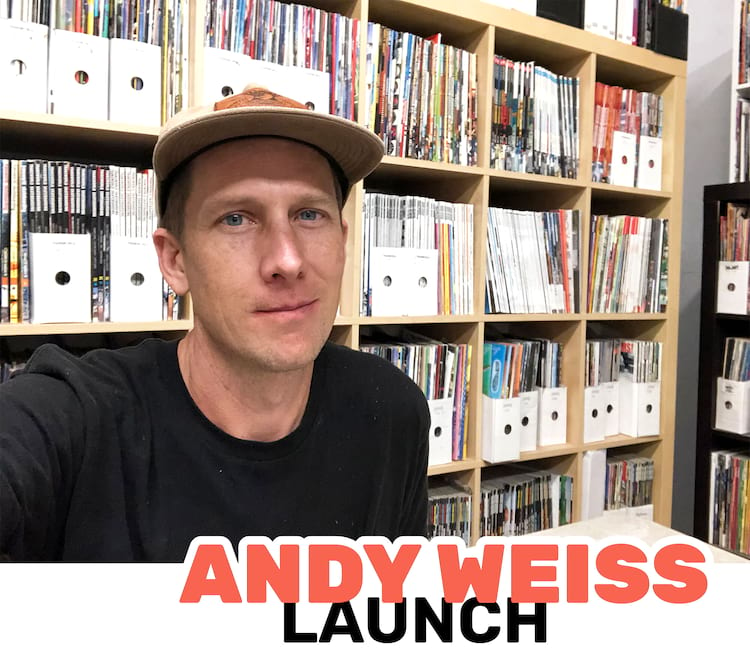
Tell me about your project.
Launch is a Northern Colorado nonprofit that promotes physical activity, hands-on learning and creativity through skateboarding. Our warehouse facility includes an indoor skatepark, a maker space, a skateboard museum and a library of skate-related literature.
How did you get started?
I opened a skateshop in Fort Collins, CO, when I was 20 years old and I ran it for 15 years. Over that time, what I enjoyed most about the shop were the people and the community events we hosted, and obviously I loved hooking kids up with product. I think my strength as a shop owner was connecting with people versus being a great retail salesman. Over time I started getting burnt out on just selling products and all the struggles involved in running a skateshop. It was around 2008 when I started to phase out of my shop. At the time there weren’t many nonprofits that were devoted 100 percent to skateboarding, and definitely none in my area. I saw a need for something, especially in our region, that would focus on the skateboarding community specifically. For many years I facilitated skate lessons and camps through my shop, and over that time I built a positive relationship with my city’s recreation department. I kinda wore two hats facilitating seasonal lessons with my city while also running my shop. So Launch started with programs I was already doing: day camps and lessons. Once we received our 501(c)3 status in 2011, the first grant the organization applied for was to fund a build-your-own-skateboard program. As a woodworker myself, I was really excited to create this program. We received grant funding for some basic woodshop tools to get the program off the ground, but we didn’t have a location yet. We basically had a portable wood shop and collaborated with other organizations to host our workshops. We fundraised for about a year, including a 2012 Kickstarter campaign, and within a year of getting our 501c(3) status we started paying rent at our current location.
Jason: Just get started and then you can figure it out from there. Maybe don’t do it alone. Try to find people who want to be involved, whether it’s on a volunteer basis or people who want to help you get started, because that’s been invaluable. I’m good at certain things but not other things and Tony fills those gaps perfectly.
Tony: The more people on your crew the better. Just connect with people. I think Jason and I are usually pretty quiet when we go to the skateshop or go anywhere, but with the program, going into No Comply or sending emails to random people, you find out that everyone’s down to help. So don’t be afraid to reach out to people.

Tell me about your project.
Launch is a Northern Colorado nonprofit that promotes physical activity, hands-on learning and creativity through skateboarding. Our warehouse facility includes an indoor skatepark, a maker space, a skateboard museum and a library of skate-related literature.
How did you get started?
I opened a skateshop in Fort Collins, CO, when I was 20 years old and I ran it for 15 years. Over that time, what I enjoyed most about the shop were the people and the community events we hosted, and obviously I loved hooking kids up with product. I think my strength as a shop owner was connecting with people versus being a great retail salesman. Over time I started getting burnt out on just selling products and all the struggles involved in running a skateshop. It was around 2008 when I started to phase out of my shop. At the time there weren’t many nonprofits that were devoted 100 percent to skateboarding, and definitely none in my area. I saw a need for something, especially in our region, that would focus on the skateboarding community specifically. For many years I facilitated skate lessons and camps through my shop, and over that time I built a positive relationship with my city’s recreation department. I kinda wore two hats facilitating seasonal lessons with my city while also running my shop. So Launch started with programs I was already doing: day camps and lessons. Once we received our 501(c)3 status in 2011, the first grant the organization applied for was to fund a build-your-own-skateboard program. As a woodworker myself, I was really excited to create this program. We received grant funding for some basic woodshop tools to get the program off the ground, but we didn’t have a location yet. We basically had a portable wood shop and collaborated with other organizations to host our workshops. We fundraised for about a year, including a 2012 Kickstarter campaign, and within a year of getting our 501c(3) status we started paying rent at our current location.
 Launch's indoor park is a combined feat of woodworking and skateboarding, both of which the kids learn here
Launch's indoor park is a combined feat of woodworking and skateboarding, both of which the kids learn here How do you fund your nonprofit?
Grant funding, corporate support and donations. Our mission is pretty open ended—we empower individuals to better themselves and their communities through skateboarding—so the grants we can seek are pretty diverse. Most grants focus on a specific category. For example, we might seek grant funding for youth anti-obesity programs. We’ve been generously funded for our art-based programs, we’ve received funding for youth-specific engagement and we receive support from health-conscious funders who support people getting outdoors and doing activities. So there’s a wide spectrum of support, and most of the foundations we work with are specific to our area. We also receive tons of small donations from community members. I did leverage some of my connections in the skateboard community to do our first fundraisers, so having a background in the skateboard industry was definitely helpful in the beginning. We still receive some support from the industry, but most of the companies that support us are either sponsoring a particular program or they’re donating product to assist with our events. For any upstart nonprofit, you gotta think about both what you need and what the benefit for the company is, too. They benefit by connecting to the customers and our organization connects with a lot of young skateboarders. Those connections with the skateboard companies took a little while. At first it was hard for them to understand what we were doing here in Northern CO. Keep in mind this was ten years ago. This was a pretty new idea at the time.
What are the advantages of running a nonprofit rather than a skateshop?
In a lot of ways it still kind of feels like I’m self-employed, but in retail it was more challenging to collaborate with other businesses. In the nonprofit world, everyone wants to help each other. We’ve had a lot more positive collaborative experiences because we can work with other nonprofits that also work with a similar demographic and have similar goals. Not to say skateshops don’t collaborate with other businesses, but I found it easier in the nonprofit world. There’s a lot of people who are just trying to help others in the nonprofit world. Launch also has a board of directors. It’s a good collective of different people who provide great insight into the direction of the organization. I do like that process. They keep me in check and help move Launch forward. With a skateshop, it’s easier to get tunnel vision. Having a board kind of keeps me accountable and keeps us focused on our universal goal.
Any downsides?
It took me a while to get into the nonprofit mindset. Obviously your revenue streams are gonna be different. Skateshops plan with pre-ordering product and those types of things, with specific seasons where you’re gonna sell certain products. With a nonprofit, we have overhead, rent to pay, a skatepark to fund, insurance to cover, so I think we have to project a little further out. In my experience, there’s a lot more planning.

What’s your advice to someone who wants to start a skate program?
The resources available today are so much greater than they were ten years ago. The folks at Skateistan have some really good resources. They’re obviously trying to do more to spark these movements and get more of these organizations going. When I started doing my research for Launch, there weren’t a lot of examples of skate-centric organizations. At the time, I went to my local bike co-op and my local nonprofit bookstore and volunteered to get an inside perspective on how those places operated. I would advise anybody who’s interested in nonprofits to go volunteer and see if it’s something you really want to do. I work with so many amazing people every day who are just so stoked. I’m surrounded by good energy. It seems like there are more and more people in the skateboard community who want to make a difference in their community, which is super rad.
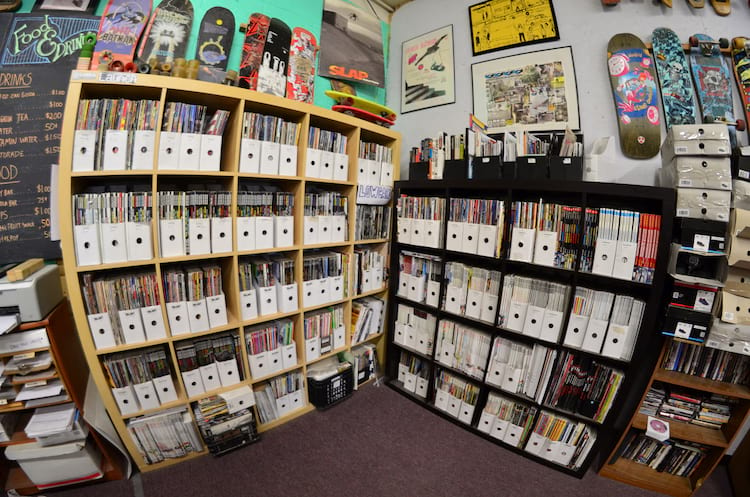 Free history lessons can be found in the library
Free history lessons can be found in the library
Interested in starting a skate program and need further guidance? Contact the good people at these places:
The resources available today are so much greater than they were ten years ago. The folks at Skateistan have some really good resources. They’re obviously trying to do more to spark these movements and get more of these organizations going. When I started doing my research for Launch, there weren’t a lot of examples of skate-centric organizations. At the time, I went to my local bike co-op and my local nonprofit bookstore and volunteered to get an inside perspective on how those places operated. I would advise anybody who’s interested in nonprofits to go volunteer and see if it’s something you really want to do. I work with so many amazing people every day who are just so stoked. I’m surrounded by good energy. It seems like there are more and more people in the skateboard community who want to make a difference in their community, which is super rad.
 Free history lessons can be found in the library
Free history lessons can be found in the library Interested in starting a skate program and need further guidance? Contact the good people at these places:
Check out more resources at The Good Push Alliance
See more skate nonprofits on our Community Resources Page
-
11/27/2024
Skate Like a Girl's "Giving Tuesday" Fundraiser 2024
Our friends at Skate Like a Girl have their Giving Tuesday campaign coming up on December 3rd. You could win free flights or a huge pack of gear for helping out. Mark your calendars and check it all here. -
10/23/2024
Unity Fest 2024 Photos
Unity Fest 2024 popped off in The Bay with four days of wild parties and hyped-up sessions from the parking lots to SOMA park. Didn’t make it? You blew it! But we got you with all the photos here. -
9/08/2024
MoMI's "Recording the Ride" Opening Photos
Nerds and notable figures from skate-video history convened in Queens for opening night of Recording the Ride—a ‘90s video retrospective at the Museum of the Moving Image. Catch all the big hitters that came out to see the show. -
8/21/2024
Sam Bolton for Spitfire Wheels X Skate Like a Girl
To launch their new Skate Like a Girl collection, Spitfire sits down with artist Sam Bolton and touches on topics from tattoo inspirations to Wheels of Fortune. -
6/05/2024
Skate Like A Girl’s “Wheels of Fortune 12” Video
For three days of mystical mayhem, a global gathering of skaters commandeered Seattle's streets with its hyped-up Witch Hunt and closed the show with a heated contest. Fresh pros and new homies keep the spirit of skateboarding strong.

